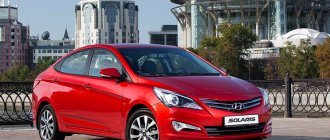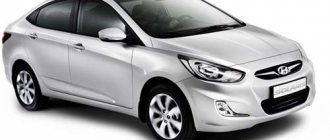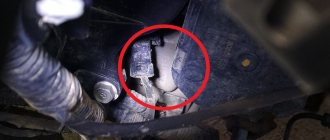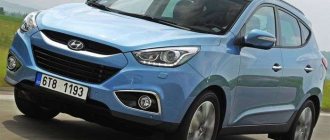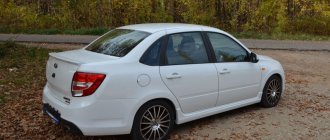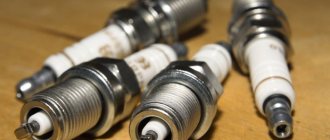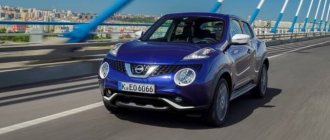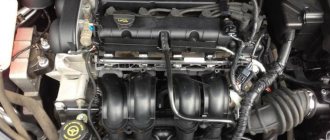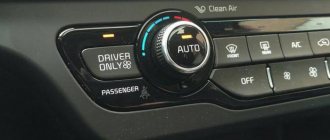When talking about new products for 2021, most car enthusiasts imagine modern crossovers. But, in fact, city dwellers quite often pay attention to sedans. They are maneuverable, compact and economical. Modern models are equipped with powerful comfort and safety systems. The new Hyundai Solaris 2021 has become a prominent representative of the South Korean brand. The restyled model looks much more expressive than its predecessor. In addition, even the basic configurations have become more rich and varied. The domestic manufacturer is not going to give up the laurels of the leader and has proposed its own view of modernization. Lada Vesta appeared in front of fans in an updated form. The designers modernized the appearance, made the interior comfortable, and the engineers paid attention to the shortcomings identified earlier and the emergence of new functionality. So which is better Lada Vesta or Hyundai Solaris? This question can only be answered by comparing all the characteristics of the models step by step.
Hyundai Solaris
Comparison of configurations and prices
The initial configuration of the “Korean” will be remembered for the appearance of halogen optics, 15-inch wheels, a heated rear window, and a tire pressure sensor. The functionality is small, but taking into account the minimum cost of 765,000 rubles, this list looks very worthy. The older assembly will cost 1,196,000 rubles, but in this case you can count on almost premium amenities - LED optics, electric trunk, keyless start and access, color display on the dashboard, leather interior, heated steering wheel and windshield, climate control and multimedia with screen. Dealers offer a choice of the following configurations:
- Active;
- Active Plus;
- Comfort;
- Elegance;
- Prosafety.
The Opponent is available in four trim levels, where the minimum includes halogen headlights, a rear fog lamp, a heated first seat, audio preparation for 4 speakers, and a remote key. The air conditioner appears in the second assembly. The maximum implies the appearance of multimedia, climate control, alloy wheels. The following configurations are available:
- Comfort;
- Comfort Multimedia;
- Comfort Winter;
- Classic;
- Classic Start;
- Exclusive;
- Luxe;
- Luxe Multimedia;
- Luxe Prestige.
The minimum price of the new product is 644,900 rubles, and the maximum price increases the cost to 964,900 rubles. Thus, the Russian sedan will cost a little less, and the list of equipment and quality is approximately at the same level.
Fuel consumption
Solaris is equipped with a pair of engines. A 1.4-liter model will consume 5.7-6.4 liters in mixed mode, depending on the type of transmission installed. The older 1.6-liter version boasts an economical consumption of 6.0-6.6 liters per hundred kilometers in the combined cycle. Vesta in the basic version was offered with a 1.6-liter VAZ engine, the consumption of which was 6.3 - 6.9 liters. Then the production of cars began with a 1.8-liter, where costs increased to 7.2-7.8 liters. In addition, the model range offers the installation of gas equipment, but the modification is not in demand.
LADA Vesta SW Cross, Kia Rio, Hyundai Solaris. My choice. The first 1100 km of operation.
Well, since I have Vesta Cross, then I will have to compare both Korean classmates with it.
Before buying this car I had to use a taxi for a week. I drove a Hyundai Solaris every day, albeit as a passenger. I talked a lot with the drivers - I must admit, the herd mentality worked, they still take it, which means I should take it too... Taxi drivers praise it. They talk about very low fuel consumption. The driving style, I see, is very moderate, economical - they fill up with their own money. Yesterday I parked next to a car like this, walked away and looked... and this is what I noted to myself. The interior in Vesta is much richer and more pleasant for me, and besides, Vesta is quieter than Solaris. My wife, while traveling in the Solaris, always complained about the lack of space in the back seat - it’s narrow and there’s not enough legroom. Vesta, even externally, will still be wider, or looks like it. Vesta is taller both in height and ground clearance. I didn’t compare the trunk; the opportunity didn’t arise. Vesta's bumpers are more “sharpened” for passing obstacles. All the same, Solaris is a very urban car. And we (my family) live quite actively, we like to go out into the countryside. I remembered how my neighbor, already a grandfather in years, complained about Solaris after Kalina - he couldn’t get to the dacha, there was a lot of noise on the highway. Yes, even in the city there is sometimes enough off-road. My impressions of Solaris are that they are a cheap car. In terms of comfort and performance, it is inferior in everything (well, maybe it’s more economical in fuel, I don’t have verified data). And it costs noticeably more than Vesta. The question arose - what to pay money for?
Today is the last day of the weekend. I have to go to work tomorrow. Met with friends, sort of family gatherings. A friend has a KIA RIO, new, purchased in April. Comfort package (minimum amenities for reasonable money). Well, of course, “reflecting” the attacks of “Korean car managers” (I’m joking, of course), I began to torture him about the car. As a result, we got into mine and drove off. The following is all from the words of a friend, the owner of a brand new KIA RIO. The RIO's ground clearance leaves much to be desired; on bumps, its lip touches the road. Driving to the dacha or going a little off-road turned out to be the same small problem - it’s a pity for the bumper... I'll break and scratch. Moreover, for some reason the bumper is located even below the car’s ground clearance line. I suggested to a friend that we remake the bumper, “sharpening” it a little to suit our conditions - again, this is an additional expense. “But for me,” he says, “the stroller fits across the trunk.” Indeed, the trunk of the RIA is a little larger. And I also had his stroller fit into the trunk of my Vesta... Ria herself is a little wider than Vesta. “I don’t like it,” he says, “when a passenger rubs his elbows with me.” We're going to Vesta... don't worry. And Vesta’s interior is actually a little narrower. And there is enough space.
“And, he says, it’s quiet in your car!” And mine is like a bathroom. To prevent noise from the road, they foamed the arches (from the outside), he says. Before that, I had a Kalina sedan, he says, and it was quieter than the Rio. For some reason Kalina was warmer and warmed up faster... True, if you warm up Rio, it’s also hot...” I ask, why didn’t you take Vesta then? Answer: “I was afraid. I thought it was suddenly bad.”
That's why I spend my time writing. Let this be only my view of the situation. Someone still looks from the same bell tower as me and perhaps this information will be valuable to him.
No matter what they say, I'm happy with my car. I see no point in wasting time and comparing it on forums of foreign analogues. But I don’t see them with the same characteristics... what to compare with? Tell! I don't claim that my opinion is the most correct.
To date, a little over 1100 km have been covered. Refueled twice. The first time I filled it with 95 gasoline. About 52-54 liters (I don’t remember, and I lost the receipt). Traveled about 600 km. Average consumption was 8.9 liters per 100 km. Then I filled it with 92 beznin, the same amount... I drove 100 kilometers less (about 500 km). So I drove the first tank a lot on the highway, but lately I’ve mostly been driving around the city, and I’ve been pushing it noticeably more, I’m not crawling like taxi drivers on a Solaris. The average total consumption today is 9.4 liters. The numbers are not encouraging, but they are not scary. I hope that after running it the consumption will decrease.
Hodovka. Residents of Barnaul know what Brilliantovaya Street is. In the summer it’s tough. In the off-season it’s rather death to the suspension. Today I drove there, the road was “levelled” by snow, but still with its inherent potholes. Vesta runs for himself, swallows the pits... the poor surface suspension works out more interestingly even than Largus. Let's just say that the difference in comfort between the gravel road and the normal road on Vesta, it seemed to me... there is almost none. I crossed the tram tracks 20 times today. I ask my wife “how do you like riding on the tram tracks?” Laughs - “was that them?” My friends, I don’t know how long this suspension will last over the kilometers, how reliable it is (time of use will tell), but it is really comfortable. But the Vesta sedan will be softer. But the stiffness of the suspension holds the car very well in turns and on ice (spun on the same Brilliant), and does not overwhelm the car. After Largus, the car is very maneuverable. By the way, even Kalina was much less agile than Vesta, my friend in Rio noted this (comparing Kalina and Rio).
Thresholds. When boarding/disembarking, you will certainly touch the plastic body kit with your foot. There is no dirt in the cold winter. The pants will be clean. And in the off-season you need to be more careful. If the seat on the Vesta was wider and its edge was located closer to the exit, then it would be easier to avoid touching the thresholds. By the way, someone, having seen enough or read tests about Vesta Cross, wrote in the chat that the seat was small... Sorry, maybe your butt is just big? Okay I... well my friend... Height 180. You can’t call her thin, but of course she’s not fat either, and he didn’t complain about her at all. Rather, he complained about the Ria seat - only the seat itself is heated, but on Vesta the back is also heated.
Ignition keys are a separate issue. I keep forgetting to experiment... Tomorrow I’ll “use it” and report back.
I wish you all the best and pleasure from driving your cars!
Enemies! Get your tomatoes out! Waiting for you! and it’s already become boring! ))))
Specifications
Dynamic qualities
In practice, it has been proven that both sedans feel comfortable on the track. Drivers are confident in the safety and predictability of the models’ behavior. Additional comfort is provided by a spacious trunk and a comfortable, quiet interior. Thanks to this, you can travel with a large group and not feel tired. The cars cope with sharp acceleration and maneuverable overtaking. Lada Vesta is capable of accelerating to 188 km/h in its maximum version, and the first “hundred” is given to it in 10.2-12.8 seconds, depending on the type of engine and gearbox. Solaris has similar performance. The maximum speed reaches 185 km/h, and acceleration from standstill to the first 100 km/h will take from 10.3 to 12.9 seconds, which determines the engine power and the installed transmission.
Handling and off-road performance
The choice of Lada Vesta or Hyundai Solaris is complicated by the presence of the same suspension. The front part is equipped with MacPherson type struts typical for the class, the rear part is represented by an inexpensive mechanism - semi-independent suspension, which allows not only to save money, but also to increase the strength of the structure. Despite the brand, both models received the correct settings and high quality elements. In case of damage, repairing a Korean car will be much more expensive than an opponent’s. But even in this case we cannot talk about large investments.
Thoughtful suspension settings allowed for maximum responsiveness. The high level of security is supported by modern assistant systems. Budget sedans do an excellent job of being manageable and comfortable both on the highway and within the city. Initially, all sedans are created with the intention of city travel. The indicated models were no exception. Due to the advent of automated gearboxes, they are comfortable for standing in traffic jams and frequent switching. Electronic assistants will help you navigate in tight spaces. Small dimensions make it possible to park in tight parking lots. These models are often considered for taxi services because they are not only reliable and easy to maintain, but are also fuel efficient.
Considering the models from the point of view of the ability to overcome difficult sections, it is worth giving the laurels of the winner to Lada Vesta, since the “Russian” has greater ground clearance than its rival. However, if the obstacle is small, then even a Korean sedan can do them. In general, both models are able to get to the dacha without damaging the bumpers and suspension.
Engines and transmission
Comparison of Lada Vesta and Hyundai Solaris is impossible without assessing engine power. The first received a small list of available power units:
- 1.6-liter 106 hp;
- 1.6-liter 113 hp;
- 1.8-liter 122 hp
For the minimum, mechanical and robotic boxes are used in combination. In this case, the maximum speed reaches 178 km/h. Acceleration from zero to “hundreds” with the first transmission will take 11.8 seconds, and for manual transmission the value will increase to 12.8 seconds. In addition, a gas-cylinder installation is provided, where acceleration will take 12.9 seconds, and the top speed will be limited to 170 km/h. The maximum 122-horsepower installation makes it possible to install a “mechanics”, which provides dynamics of a maximum of 188 km/h and reaching the 100 km/h mark in 10.2 seconds. With a robotic gearbox, the values will be 186 km/h and 12.1 seconds. Consumption for minimal modifications is 6.3-6.9 liters, older ones “eat up” 7.2-7.8 liters. The fuel tank holds 55 liters.
The Korean sedan also has a choice of engines. Dealers offered:
- 1.4-liter 100 hp;
- 1.6-liter 123 hp
The initial version is combined with automatic transmission. The maximum acceleration is 183 km/h, and the time to the first 100 km/h reaches 12.9 seconds. The manual transmission promises to increase dynamics to 12.2 seconds and top speed to 185 km/h. Combined cycle consumption varies from 5.7 to 6.4 liters. The maximum is combined with the same gearboxes and gives a value of 193 and 192 km/h at maximum and an acceleration time of 10.3 and 11.2 seconds in favor of a manual transmission. The consumption will be 6.0 - 6.6 liters. The fuel tank holds up to 50 liters of fuel. As a result, the Korean sedan is capable of reaching higher speeds and provides more economical fuel consumption, but in practice the difference is almost unnoticeable.
Maintenance costs
As expected, maintenance costs were lower for the Russian model. The restyled Solaris, of course, will cost more, but it cannot be called expensive either. Every motorist can afford to own these cars. At the same time, experts do not exclude the possibility of high costs if the machine was used carelessly and was not serviced on time.
Dimensions of Vesta and Solaris
The Lada is bigger and looks more solid. Solaris has a body length of 4370 mm, and Vesta has a body length of 4410 mm. The width ratio is 1764 mm versus 1700 in favor of the Lada Vesta. Despite the fact that the ground clearance of the Russian new product is 11 mm higher (171 – 160 mm), there is no feeling of instability. Apparently the wheelbase, which is smaller in Hyundai (2570) than in Vesta (2635), smoothes out the impression of a high seating position. Visually, Solaris looks more squat, but somewhat old-fashioned, although the objective data on aerodynamics are almost equal. The large size of a Russian car can clearly be counted as a plus.
Exterior and interior
The appearance of each option is no longer a secret for car owners. Sedans are already on sale. Despite the similarity in size, they look completely different. “Korean” shows the dynamism of the exterior, while Vesta is aimed at demonstrating stampings and corporate identity.
Features and differences in appearance:
- The front of the Solaris attracts attention with its well-thought-out lines. It seems that the signature radiator grille “grows” into narrowed headlights that extend to the middle of the bumper. The lower part is extremely stamped and looks impressive. The rival is distinguished by its strong commitment to the X-design proposed by the chief designer of AvtoVAZ. To visually increase the price, chrome was added to the narrowest place. For operational efficiency, large headlights with a simple design were installed;
- If Solaris continues the theme of straight lines and stampings on the sides, then Vesta “surprises” with another “portion” of X-shaped design. The stamping reminds us that this is a Russian sedan with a corporate style. The rest of the design follows the typical concept of the class;
- at a quick glance it may seem that the Lada is copying the rear of the Hyundai, but with the typical tendency towards clumsiness. All lines are concrete and less smooth. The brightest element is the headlights. In two cases they received the same shape, but designers from Korea played with them with smoothness and lightness, while Russian designers presented them in a masculine, hypertrophied form. Solaris in the lower part receives two fog lights at the edges, the enemy - only one in the middle.
The difference in interior design is obvious, although Russian manufacturers sought to increase the budget for the materials used. The dashboard looks stylish with three deep wells located behind the multifunction steering wheel. In older trim levels, a large screen is included in the list of standard equipment, but in lower trim levels you will have to pay extra for it. Solaris looks stylish and modern. In the older version, a functional screen appears on the dashboard. In the middle there is a large multimedia screen that extends beyond the front panel. In general, both versions received a comfortable interior for long trips, fairly designed for 5 people.
dimensions
Although the models were created by different manufacturers, they were very close in size to each other. The length/width/height of the “Korean” is 4,370/1,700/1,470 mm, while the Russian design boasts 4,410/1,764/1,497 mm for similar parameters. The domestic car is a little larger than its “neighbor”, but in practice it is almost impossible to feel the difference. Compact dimensions give a feeling of comfort for use around the city. Outside of it, cars stop behaving so confidently on the road when it comes to rough terrain. The fact is that the ground clearance remains too low to pass serious obstacles. The ground clearance height for Solaris was 16 cm, for Vesta - 17.8 centimeters.
Luggage compartment
Following the size, the volume of the luggage compartment is compact. However, these figures are considered decent for their class. The trunk of Vesta can accommodate 480 liters, while the enemy allows you to transfer up to 410 liters. Both models feel great when traveling to the country. If necessary, you can fold the back of the second row.
Interior
Both cars are comfortable inside and feature a modern, ergonomic design. The quality of the upholstery and plastic corresponds to the class of cars and does not raise any complaints. There are no extraneous creaks or unpleasant odors in the interior of a new car, both Vesta and Solaris. The advantage of the Lada is its larger interior volume, which is especially noticeable to passengers in the back seat, while its competitor's driver's seat is more comfortable when driving. According to the majority of warriors who tested both cars, the Solaris interior looks more stylish, and the control of all instruments is more logical and clearer.
Comfort and safety systems
The cars are equipped to a higher level than they actually cost. Modern systems ensure a comfortable stay in the cabin, and the driver is confident in the safety of both passengers and pedestrians. The list of equipment includes electronic assistants. The quality of the built-in elements is beyond doubt. Russian engineers have seriously worked on the reliability of the equipment. The shortcomings were eliminated, and the model was updated on the basis of this. Both sedans, even in minimal configurations, taking into account the price, are equipped quite well.
Conclusion
If you don’t pay attention to the cost of cars and compare similar configurations, then you have to admit that the Hyundai Solaris looks more dynamic and attractive than its competitor. There is no noise, the car looks more powerful, there are more pleasant little things in the cabin, etc.
But, as soon as it comes to practicality, driving comfort and cross-country ability, then the Russian car becomes the undoubted leader. It is more adaptable to bad roads and is pleasant to sit and drive inside. The suspension is more comfortable, there is more space in the cabin, and passengers have much more space.
You can also read on this topic:
Fuel consumption of the UAZ Patriot of the updated model has decreased
Mercedes S63 in body 222 after 2 years of operation
Kia Motors has approved credit programs for its cars, available in September
Meet the 2021 Hyundai Sonata N Line
The most expensive Lada Largus Cross will appear on the car market in September
Share on social networks
Dmitry Seregin August 3, 2017
Published in: Korean cars, Russian cars
Tags: Hyundai, AVTOVAZ, In Russia, Korean cars, Korean foreign cars, Our cars, new products, New, Russian cars, sedans
What to buy in the end?
It is impossible to unequivocally answer the question of which is better than the Lada Vesta or Hyundai Solaris, since both sedans belong to the budget class and have many advantages, including good quality and a high level of equipment for the category. The update not only brought new design elements to the models, but also increased the level of reliability. During the restyling process, the “weak” elements were improved. Lada will cost a little less, but will provide the same “set” of efficiency, quality and style. It will require less costs not only during purchase, but also in further maintenance.
Since models develop not only technically, but also improve their appearance, the number of customers is also growing. The popularity among female drivers is also due to the emergence of automatic and robotic gearboxes. Men also do not give up comfort with the opportunity to save money. The manufacturer has provided a huge range of colors, which reinforces interest in the models.
The cars have been proven to be ideal for everyday use. Small dimensions make it easy to find a parking space, and an automatic transmission or robot allows you to stand comfortably in a traffic jam. Long journeys can also be comfortable. The spacious interior provides a real possibility of seating for five people. The maximum dynamics and acceleration time of the models are approximately the same, so the indicator cannot become decisive in the choice.
The popularity and liquidity of sedans is proven by frequent work in taxis. Fast driving, maneuverability and ease of repair are not the whole list of advantages. Both Hyundai and Lada are comfortable for driving on light off-road conditions. In this regard, they are often used for trips to the country or to nature. True, for a long vacation the trunk may be too small.
Rear seats
It is easiest to get into a Lada, although its low and graceful threshold will be dirty in the slush, as in foreign cars. And in Hyundai and especially in Kia, when landing, you should bend your head more: leaning against the low slope of the roof is as easy as shelling pears.
Rio is the tightest of all, Solaris is more spacious, and the champions in terms of space are Vesta and Polo. True, they do not have lampshades. But unlike the Koreans, Lada and Volkswagen do not skimp on the pocket on the back of the driver’s seat, the door rails and the third headrest.
Lada Vesta
Hyundai Solaris
Kia Rio
Volkswagen Polo
A year and a half ago, few in class B offered rear view cameras. And now everyone except Kia has them in top versions! Our four have parking sensors in the list of options, but only Volkswagen allows you to order not only rear sonars, but also front ones, and this is already available in the “middle” version of Comfortline.
Lada Vesta
Volkswagen Polo

